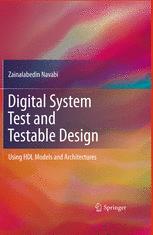

Most ebook files are in PDF format, so you can easily read them using various software such as Foxit Reader or directly on the Google Chrome browser.
Some ebook files are released by publishers in other formats such as .awz, .mobi, .epub, .fb2, etc. You may need to install specific software to read these formats on mobile/PC, such as Calibre.
Please read the tutorial at this link: https://ebookbell.com/faq
We offer FREE conversion to the popular formats you request; however, this may take some time. Therefore, right after payment, please email us, and we will try to provide the service as quickly as possible.
For some exceptional file formats or broken links (if any), please refrain from opening any disputes. Instead, email us first, and we will try to assist within a maximum of 6 hours.
EbookBell Team

4.8
34 reviewsDigital System Test and Testable Design: Using HDL Models and Architectures by: Zainalabedin Navabi This book is about digital system test and testable design. The concepts of testing and testability are treated together with digital design practices and methodologies. The book uses Verilog models and testbenches for implementing and explaining fault simulation and test generation algorithms. Extensive use of Verilog and Verilog PLI for test applications is what distinguishes this book from other test and testability books. Verilog eliminates ambiguities in test algorithms and BIST and DFT hardware architectures, and it clearly describes the architecture of the testability hardware and its test sessions. Describing many of the on-chip decompression algorithms in Verilog helps to evaluate these algorithms in terms of hardware overhead and timing, and thus feasibility of using them for System-on-Chip designs. Extensive use of testbenches and testbench development techniques is another unique feature of this book. Using PLI in developing testbenches and virtual testers provides a powerful programming tool, interfaced with hardware described in Verilog. This mixed hardware / software environment facilitates description of complex test programs and test strategies. •Combines design and test •Describes test methods in Verilog and PLI, which makes the methods more understandable and the gates possible to simulate •Simulation of gate models allows fault simulation and test generation, while Verilog testbenches inject faults, evaluate fault coverage and apply new test patterns •Describes DFT, compression, decompression, and BIST techniques in Verilog, which makes the hardware of the architectures easier to understand and allows simulation and evaluation of the testability methods •Virtual testers (Verilog testbenches) play the role of ATEs for driving scan tests and examining the circuit under test •Verilog descriptions of scan designs and BIST architectures are available that can be used in actual designs •PLI test utilities developed in-text are available for download •Introductory Video for Verilog basics, software developed in-text, and PLI basics available for download •Powerpoint slides available for each chapter